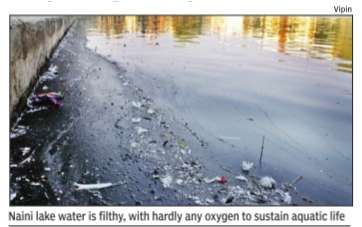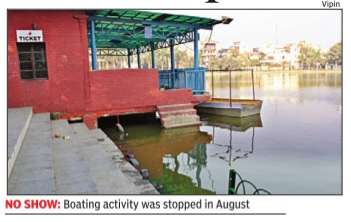Delhi: N
This is a collection of articles archived for the excellence of their content. |
Contents |
Naini Lake
2016/ Efforts to Restore
(Model Town)
Paras Singh, AAP-BJP tussle kills revival plan of dying city lake, Dec 29 2016 : The Times of India
A plan to revive the dying Naini lake in Model Town was prepared in 2015 by a top biologist but it hasn't been implemented as control of the lake changed hands from the city government to the municipal body.
On August 3 this year, the BJP-controlled north corporation decided not to renew the Delhi tourism department's lease to manage the la ke. This was after a sustained citizens' campaign had forced the department, which comes under Delhi government, and north corporation to sign an MoU to revive the lake. The civic body junked the agreement, deciding in stead to “redevelop“ the lake on its own despite being cash strapped. Five months have elapsed, but Naini's water is still greenish and turbid, devoid of life. Its regenration will provide a blueprint for revival of other waterbodies, say environmentalists.
Corporation functionaries were found to be clueless about the ecological revival of the lake and focused instead on restarting recreational activities such as boating.
The turbid, green water, experts say, indicates algal bloom and low dissolved oxygen.Meanwhile, the civic body continues to pump groundwater from borewells into the lake.
Biologist C R Babu from the Centre for Environmental Management of Degraded Ecosystems, who had drawn out a plan to ecologically revive the lake last year, explained why the move would further damage the lake. “ A living water body has a natural inlet and an outlet. But here groundwater through borewells is being used to recharge water. And since the water table in the area is less than 30 feet, the water being pumped up may be highly saline and destroy the lake instead of reviving it,“ Babu said.
When the corporation decided to go solo, the tourism department had stopped boating activity from August 10 2016. Along with that, the canteen and the musical fountain were also shut. The corporation had roped a private company but it left within a month. “Plans would be tentatively completed by April-May . We are making a policy about outsourcing it to a company which has expertise to operate the lake,“ said V P Pandey , the leader of house in north corporation.
Najafgarh
Nangal Dewat
18th or 19th-century temple
Richi Verma, Temple without a name to get fresh lease of life, April 11, 2018: The Times of India

From: Richi Verma, Temple without a name to get fresh lease of life, April 11, 2018: The Times of India

From: Richi Verma, Temple without a name to get fresh lease of life, April 11, 2018: The Times of India
A two centuriesold temple in southwest Delhi would be conserved for the first time by the archaeology department of the Delhi government and Intach Delhi Chapter.
The temple at Nangal Dewat village is considered a rare and beautiful building, much of which has been damaged.
This is the first and only temple on the list of heritage buildings shortlisted by the government and Intach; the rest are mosques, gumbads, gardens and tombs etc. Not much is known about the temple, though it is quite revered and visited by a large number of worshippers even from far off places. “The temple appears to be an 18th or 19th-century structure. Its fine plasterwork is in the late Mughal style,” said an official.
Officials say the temple interiors have many striking paintings that would be conserved. “First, the paintings will be cleaned, then consolidated. There are many points where the plaster is peeling off and that has to be carefully corrected. There are some sculptures that are damaged or dilapidated and which we will consolidate. Our part will involve only strengthening and consolidating the paintings or sculptures; we will not be recreating anything broken,” said an official.
The external facade would also be cleaned and repaired wherever necessary.
Nangal Dewat village has a fascinating history itself. Some say the freedom struggle began from this village and Jawaharlal Nehru himself had visited the village in the 1930s to praise the villagers for their courage.
“Delhi has had urban settlements for many centuries, and is famous for its numerous fortified cities. At the same time there are many villages that often have a longer history than the urban centres. Some of these villages, which were established on the flat plain of the Yamuna, have traditionally had predominantly farming populations. Some that are on the drier and more uneven terrain might have had a more pastoralist occupation,” said an official.
The project has seen three phases so far and the conservation of over 50 monuments. The temple is part of the fourth phase. A detailed project report (DPR) has been prepared with a comprehensive architectural documentation, condition analysis and archival exploration. The document would not only guide the forthcoming conservation work but also become a strong documentary record for the future.
Nangloi
Bheem Nagar
The Bheem Nagar jhuggi cluster in Nangloi, west Delhi, makes a mockery of PM Modi's ambitious Swachh Bharat Mission. Not only are slum dwellers here forced to defecate in the open, locals claim more than 50 people have lost their lives in the process.
These people were run over by trains while crossing railway tracks to answer nature's call in the last 10 years. Bheem Nagar is part of an eight-odd kilometre stretch between Langoi and Sakur Basti railway stations, which officials say has claimed over 100 lives in 10 years, including 35 in 2016.
Scores have lost their limbs to onrushing trains on the Delhi-Bathinda section of Northern Railways. The slum is just 10 metres away from the tracks. Around 100 passenger and goods trains pass through every day .
There's a single toilet complex with 30 cubicles for the 5,000-odd residents of the slum, forcing a majority of them to defecate near the tracks. Most of the deaths took place between 5am and 9am and 4pm and 9pm, when visibility is often low. The recent death took place barely a month ago. Ashok Mistry, a 40 year-old carpenter, left his house at 8.30pm in the first week of December, telling his family he would narrate an interesting tale after answering nature's call. But what the family got was a grim news.
“A neighbour came to tell us that his head was severed after a train hit him,“ says his 13-year-old son Mohit Sharma with tears rolling down his eyes. The family got no compensation and Ashok's widow now works as a maid's job to feed her two kids.
Such tragic tales abound in the slum. The stomach of a pregnant woman was ripped open and the unborn baby fell out after she was hit by a train in 2007, say locals. Both died on the spot. “Nobody in the slum could eat their meals that day ,“ says Deepak Kumar, a neighbour.
Three years ago, Ganpat Mahto, who walks with a limp, and his half-blind wife lost their only son Pramod Kumar while he was crossing the tracks around 6am three years back. Now, there's no one to help the ageing couple when they fall sick, which is quite often.
Lali Kumari, 15, lost her mother in the tracks when she was five. Her father has since re-married but the loss still haunts the child.
Locals say people often fail to judge the actual speed of an approaching train and get hit. In foggy days, trains are not visible till it's too late.Because it is a not a restricted zone, trains do not blow horn while passing through this slum cluster at full speed.
Shahzad Ali, a tailor whose shop overlooks the killer tracks, has seen several people die on 500-metre stretch of the railway line.
“Nowhere in the world would so many people have died while defecating,“ says Mausin Khan, a local.
While gory tales of death are on everybody's lips in the slum, children still play near the tracks and often cross over to the other side for urinating. Some slum residents such as Baby Singh blame evil spirits for the deaths. “ At night, white-clothed men walk on the tracks. They suck people under the trains,“ says she. Children listen to such stories with rapt attention and promptly return to resume their play .
There is, however, less emotion on view as railway officials at Langoi station share data on deaths on the tracks. Says Milan Kumar, superintendent of Langoi, “Every year, 10 to 15 deaths are reported on railway tracks between Langoi railway station and Sakur Basti railway station. According to official reports, 35 people died on this stretch in 2016.“
Naraina
Loha Mandi, 2016
The Times of India, Sep 03 2016

Paras Singh
Four decades after its shift from Motia Khan, the iron market at Naraina is still grappling with infra problems. It all started on a very promising note, though
The shifting of Loha Mandi (iron market) from Motia Khan to Naraina in 1975 shows that the authorities have to be firm with wholesale merchants when relocating them, yet simultaneously take care to provide them better amenities than they are currently used to. Undertaken though forceful means rather than collective persuasion, the Naraina shift was swift and smooth.
“Those were the days of the Emergency and the might of the state was behind Sanjay Gandhi, whose right-hand man Jagmohan had conceived of the project,“ recalls one of the oldest iron traders at Naraina.
“They placed the bulldozer in front of our shops and asked us to move to the current site which then used to be a jungle.“
Almost all of Motia Khan's 750 traders were shifted to the outskirts at one go. Agarwal remembers that most were reluctant to move, but were promised better facilities in Naraina. “We operated in tents in the initial days,“ the elder merchant adds. Today, the loha mandi is a hub for more than a thousand traders. Setting up shop in Naraina successfully diverted unwanted traffic from an already crowded Sadar Paharganj.
It is not all paradise, however.Traders complain that the basic infrastructure has deteriorated. “The roads are damaged, there is no provision for parking of trucks or efficient drainage and sewage system,“ points out Vilayati Ram, who heads the Iron Merchants' Welfare Association and is among the few remaining iron traders who also operated from Motia Khan.
Neb Sarai
Murals and art
The Times of India, Sep 29 2015
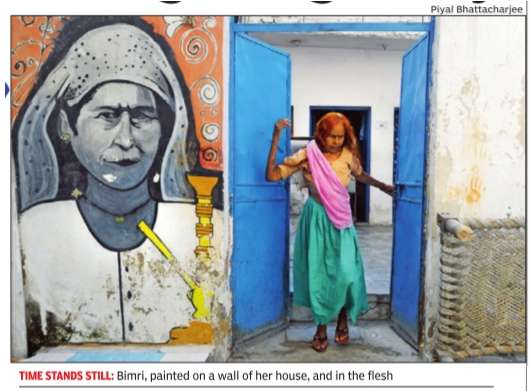

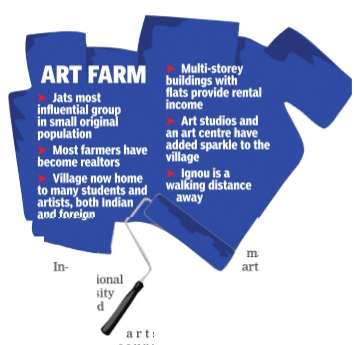
Risha Chitlangia & Richi Verma In Neb Sarai, each wall is a canvas and every street a living art gallery
The pursuit of art and “struggle“ go hand in hand, but for broke artists living on a dream to make it big, Neb Sarai village in south Delhi offers an affordable roof and unlimited canvas space. Most streets in the village have a wall or two painted over with a portrait or abstract art--the work of resident artists. While the villagers don't understand all of the ideas behind the murals, they are appreciative enough to let their own children assist and learn from tomorrow's masters. Without the artists, Neb Sarai is mere haphazard growth--unauthorized and lacking basic amenities for its mushrooming population. But in its middle lies NIV Art Centre that has become a platform for struggling and upcoming artists to sharpen their skills and reach a wider audience. Painters, sculptors, street artists, caricaturists and designers from across the country make it a base in their early careers.
Although NIV opened in 2007, it became popular only after Indira Gandhi National Open University (Ignou) started a masters programme in fine arts.“The full-time course attracted a lot of budding artists, most of whom lived in this village,“ said Avtar Singh, a painter from Punjab who was in the first batch.
Shailesh, a sculptor from Uttar Pradesh, chose to live there because “If you want to make it in the art world, you need to live close to the community .“ He needs to use strongly smelling chemicals that few landlords would tolerate but in Neb Sarai he found space for a studio quite cheaply . He has lived in the village for three years and says, “The locals are cooperative and accommodating. R Ritesh, an art historian who works with Niv Art Centre, said even foreign artists live in the village. “Every year, around 300 art ists come and go at the centre.“
Some artists leave in weeks, others stay on for years. “The vil lage is a perfect loca tion as we are close to the mainstream market, and yet affordable, said Singh. Room rents vary from Rs 5,000 to Rs, 12,000 depending on the space and privacy they offer. Bimri's portrait greets passersby from the outer wall of her house. She let a young artist paint it and says, “It is nice to have these people in the village. They have painted the walls with beautiful colours.“
The 70-year-old has seen Neb Sarai transform from a cluster of “huts and very few pucca houses“ in the days when most of its residents worked as labourers.“This is no longer a village but just like any other colony,“ she added.
Two lanes ahead, Phoolwati proudly shows a mural of monkeys painted on an outer wall of her house. Her 10-year-old son had helped the artist and got to learn from him in return. “He has painted some murals inside the house as well,“ she said.
Neela Hauz Biodiversity Park
Neela Hauz lake is regenerated
Jasjeev Gandhiok, Lake's blues end with green push, Nov 15 2016 : The Times of India
Once A Dumping Ground, Neela Hauz Now A Symbol Of Environmental Regeneration
The Neela Hauz lake, a natural depression near Sanjay Van in south Delhi, once the source of drinking water for the locality , had turned into a dumping ground for malba and raw sewage from the surroundings. After its revival through entirely natural means, the lake is now the symbol of environmental regeneration at the Neela Hauz Biodiversity Park, Delhi Development Authority's latest addition to such green belts in the capital.
When local residents approached Delhi high court about the dismal condition of Neela Hauz, the area was handed over to DDA under its Delhi Biodiversity Foundation, and scientists and engineers started the revival process immediately . Within two years, the lake had been desilted to enable landscaping of the biodiversity park. Alongside, a wetland was constructed, which now treats close to a million litres of water every day through natural processes.
“No energy is being consumed for the process,“ said CR Babu, professor emeritus, Delhi University , and head of the Centre for Environmental Management of Degraded Ecosystems. “We are only using tanks and aquatic plants with special properties to clean the water.“
According to Babu, the process to design the constructed wetland took around two years. Just before the water enters the lake, it flows past a series of alternating troughs and gravel beds with aquatic plants growing on them. The professor explained that microbes generated by the 20 different types of aquatic plants cleansed the water of biotoxins, while sludge and fine particulates were removed via a gradual process of passing the water through layers of pebbles of varying sizes. “No sewage treatment plant in Delhi has proved this efficient in improving water quality , and we have achieved this through an all-natural process,“ said Babu.
When the scientists discovered that the water flowing into the lake was extremely high in phosphates and nitrates, an aquatic species called lemna was introduced. They not only naturally absorbed these compounds, but, as Yasser Arafat, who worked on the water body purification, narrated, “We used these nitrate and phosphate-rich lemna as fertilisers after collecting them from the water.“ The lake's biological oxygen demand (BOD) levels, along with the level of phosphates and nitrates, fell sharply. According to Faiyaz Khud sar, scientist in charge at DDA 's Yamuna Biodiversity Park, the revived water body at Neela Hauz is already attracting avian and aquatic species. “A dual purpose is being served through the constructed wetland system,“ said Khudsar. “The biodiversity park is producing plants that can be used as fertiliser, and at the same we are seeing the arrival of ducks there.“ Since its revival, 70 bird species have been sighted at Neela Hauz.
The regeneration model has proved so successful that officials have submitted the concept to Delhi Jal Board for implementation in other water bodies across Delhi. “We have shown the plan to the DJB. The water supply agency felt this system could be used in over 69 water bodies without the costs being very high because no additional energy would be consumed,“ said Babu.
2019/ Becomes a dumping ground again
Jasjeev Gandhiok, May 14, 2019: The Times of India
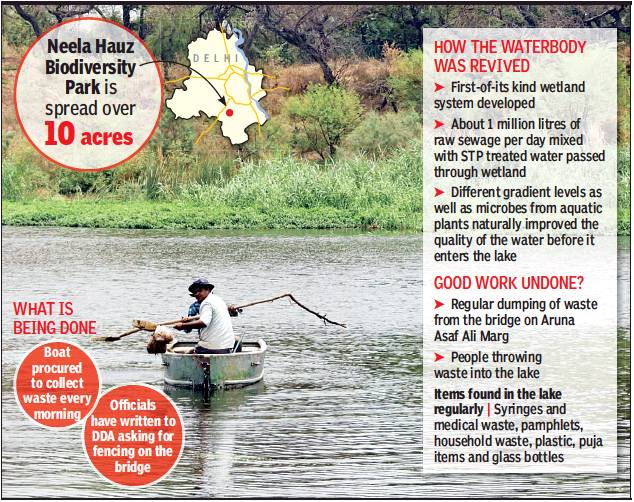
From: Jasjeev Gandhiok, May 14, 2019: The Times of India
The Neela Hauz lake — a natural depression next to Sanjay Van in south Delhi that was a dumping ground for malba and raw sewage before it was revived just three years ago — is again under threat due to dumping of waste.
As the lake lies on Aruna Asaf Ali Marg, commuters just park their vehicles on the side of the road and dump waste directly into the waterbody. This ranges from municipal solid waste, plastic bags and bottles, glass to puja material, and often even includes biomedical waste like syringes, according to officials of the biodiversity park under Delhi Development Authority (DDA).
A boat has been procured recently, which makes rounds across the lake every morning to “sweep” the waste. “The first thing we do each morning is to take a boat ride and two staff members carry out a clean-up,” said Yasser Arafat, in-charge at Neela Hauz, who had also worked on the revival project.
“We retrieve all types of waste items. Plastic bags can be seen floating on the surface, but heavier items sink to the bottom and are more difficult to remove,” he added. Park officials have even found carcasses of dogs. “People also offer prayers like they do at the Yamuna and puja materials have been found on a daily basis. We have tried to stop people but they seldom listen,” Arafat said. Park officials have also written to DDA, requesting for fencing along the main road. “We hope that a net or some sort of fencing will stop the problem,” said Arafat.
Centre for Environmental Management of Degraded Ecosystems (CEMDE) had started reviving the lake in 2015 and finished a constructed wetland system, which naturally purifies the water reaching the lake, in 2016. Neela Hauz soon emerged as the ‘model’ lake for reviving the capital’s waterbodies.
Faiyaz Khudsar, scientist-in charge at Yamuna Biodiversity Park, said the lake was seeing an increase in the arrival of birds each year, but the waste might disturb the habitat. “It is important to note that these wetlands are life-supporting systems.” People should think 10 times before throwing any waste into a waterbody, especially one like Neela Hauz that has been restored from a raw sewage drain into a beautiful wetland, Khudsar pointed out.
A study carried out by park officials in 2016 to assess the water quality before and after the revival revealed that the dissolved oxygen levels had improved from 0 to 3.4mg/l, and the biological oxygen demand from 40 to 4mg/l. The phosphate count, too, improved from a high of 103mg/l to just 14mg/l.
Nehru Place
2016: Hawkers’ prices driving shopkeepers out
The Times of India, May 12 2016
Risha Chitlangia
Civic Upgrade, Squatter Eviction Stalled In Blame Game Between DDA, Traders
Nehru Place was planned as a space for work, shopping and recreational activity. For long, however, the market was purely a commercial hub for computers and accessories. Of late, with new restaurants opening, the district centre is finally assuming the contours of the originally conceived multifunctional public space. That is the good news. The bad news is that nobody among the current business owners at Nehru Place thinks the market is ready for its new avatar. Nehru Place was developed by the Delhi Development Authority in the late 1970s, and its age is showing: broken pavements, wires dangling dangerously above the avenues, inadequate toilet facilities, poor illumination after sunset and massive encroachment by hawkers.The existing amenities simply cannot meet the needs of the three lakh people who visit the place every day . With the Janakpuri-Botanical Garden Metro line opening soon, the burden on Nehru Place could become unsurmountable. Amid this chaos, a blame game goes on. The traders' association says that all requests for basic civic services and a check on encroachment have fallen on deaf ears. DDA officials counter, “Shop owners and building owners are responsible for the maintenance of the individual buildings.“ DDA transferred the maintenance of the district centre to the South Delhi Municipal Corporation in 2014, though the civic body is responsible only for upkeep of the common areas. DDA offi cials say that the original allottees were supposed to form an association to undertake repairs and maintain the market, financed partly by a portion of the ground rent collected by DDA. But the association was never formed.
“Dustbins are overflowing with waste, trash is piling up in the corridors, and the toilets are extremely dirty ,“ complained JK Gupta, chairman of the Nehru Place Welfare Association. “There are just four-five public toilets here.“ For their part, South Corporation officials said 20 sanitation workers are deployed daily at the market. Almost every available space in the piazza has been taken over by hawkers selling everything from cellphone covers to books and shoes. “The illegal vendors return within days of their removal by corporation officials,“ resented Rajinder Gupta, vice-president of the traders' association.
Not surprisingly , this has affected business. “We have lost more than 50% business to these hawkers,“ said Naushad, who runs a mobiles accessories store. “They sell inferior quality goods but at much lower prices. Why would people come to our stores?“ He is contemplating shutting shop because business returns are not commensurate with the rent he pays.
The market was declared a no-hawking zone in 2000, but the decision was challenged in the Delhi high court by some vendors. While transferring the market, DDA gave South Corporation a list of 114 vendors authorised by the court to hawk their wares at Nehru Place.“We can't remove them, but we routinely swoop down on illegal hawkers,“ claimed Mona Sreenivas, deputy commissioner (central zone), South Corporation. “It is Delhi Police's responsibility to keep a check on unauthorised vendors.“
There is still hope for the market because urban planners feel a rejuvenated Nehru Place could make public spaces accessible to the people living in colonies in the vicinity of the market. Arunava Dasgupta, head of urban design at School of Planning and Architecture, which has carried out two studies for internal use, said, “There is a possibility of greater engagement with the public by providing community-oriented services. With slight design changes, the whole area, the market included, can be revived as a social-cultural hub. The district park nearby could be used for art and cultural activities too.“ Nehru Place awaits that reincarnation.
New Friends Colony (NFC) market
1976 to the 2017-18 renovation
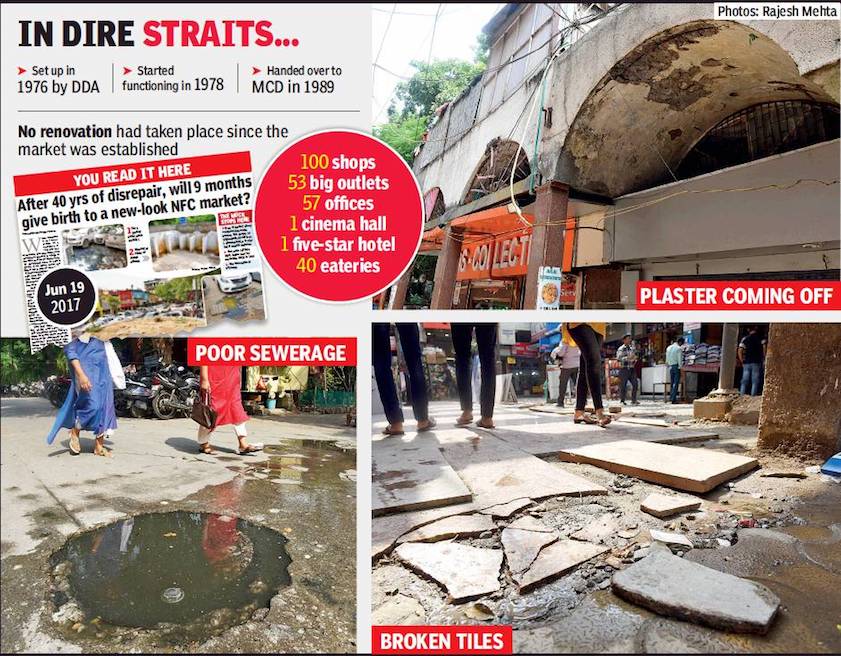
From: Paras Singh, Is NFC market worse off than when makeover started 14 months ago?, September 24, 2018: The Times of India
GROUND REALITY: Promises Of A CP-Like Revamp In Nine Months Remain On Paper
Call it the excitement of his party having won a third consecutive civic body elections or plain bravado, BJP state unit chief Manoj Tiwari last year announced grand plans to revamp the New Friends Colony market on the lines of Connaught Place. That was June 2017. Tiwari had talked of a nine-month deadline for the makeover of a market that lies in the vicinity of a category A residential colony and a five-star hotel, but is a picture of neglect.
Almost 14 months on, half of the market floor remains dug up, the portion that was relaid with fancy inter-locking tiles is weathering away and manholes are overflowing with sewage — scenes that are nowhere close to even a rundown commercial centre, forget CP. Some traders would argue that the market is actually worse off than when the so-called redevelopment started.
Shop owner Madan Pasi has to brave a constant stream of sewage daily. “Twice a day, around 11am and 7pm, the stink is unbearable. This, after drains were relaid on our side of the market,” Pasi says, his face covered with a handkerchief. Rajesh Singh, who runs a shop near the parking lot, questioned the quality of work being done. “I’m told that they are spending Rs 5 crore on this project. Really?”
Set up in 1976 by DDA, the market has 153 outlets, 57 offices, a cinema hall and 40 eateries — but it has never seen any full-scale renovation. Though it was handed over to the erstwhile MCD in 1989, both DDA and the corporation have passed the buck for the mess.
Things looked likely to change when the lofty announcements were made last year. Had these promises been kept, the market would have now boasted fresh sewage lines, at least three new urinals, water ATMs and disabled-friendly mobility. The corporation had even vowed to erect a gigantic tricolour — just like the one in CP’s Central Park.
However, when TOI visited the market, it found that while the filthy open urinals had been demolished, new ones were yet to come up. As a result, at any point of time, people can be seen using the walls near the market entrance to relieve themselves. Shyam Gupta, president of NFC Market Association, said the project was taking longer than expected, but expressed happiness that “some progress” had been made — street lights are functional again and stormwater drains are being relaid.
However, TOI found that the space behind Gupta’s shop was still filled with putrid water and the new tiles had been damaged while installing the street lights. Gupta said he had to use his own funds to beautify the shop entrance because nobody else would.
Around 100 metres away, a number of condemned vehicles continued to occupy space in the parking lot. “The whole parking lot gets filled with sewer water at the slightest hint of rain. The drains are choked by the debris,” a parking attendant said.
BM Bakshi, who heads NFC RWA, rued that politicians never looked back after making tall promises.
